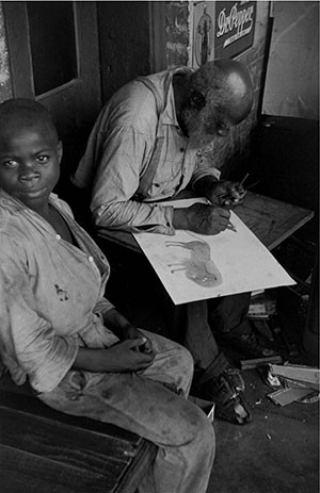Born 1854, Benton, Alabama
Died 1949, Montgomery, Alabama
Born into slavery, Traylor is believed to have produced most of his existing work after he moved to Montgomery, Alabama, in 1939. He received support early in his career from Charles Shannon, an artist from Montgomery who, with a group of artists and writers, created New South, a center dedicated to preserving southern culture. With Shannon’s backing, Traylor had his first public show at New South in 1940, presenting about one hundred of his drawings. Victor D’Amico, education director at MoMA , organized an exhibition of Traylor’s work at the Fieldston School in Riverdale, New York, in 1942, which introduced the artist to a broader New York audience. This also provided an opportunity for Alfred Barr, MoMA’s director, to purchase Traylor’s work for the museum and for his private collection, but his paltry offers so irritated Shannon that no deal was ever completed. It took almost forty years before the artist’s work was featured in another solo exhibition, and that was long after his death. Then in 1982 thirty-six of his works were included in the landmark exhibition Black Folk Art in America, 1930–1980 at the Corcoran Gallery of Art in Washington, DC, after which he gained a national following.
In Traylor’s vignettes flattened figures appear suspended over the bare paper ground. Using humble materials such as poster paint, tempera, charcoal, and cardboard, the artist animated each scene and captured subjects in tensed movement. A deer, at the apex of its leap, is shown in profile, its downward trajectory threatening to take it beyond the pictorial field. A snake writhes, trapped in the vacuous swath of cardboard surrounding it. Traylor’s genre scenes are equally dynamic, as some figures interact within architectural settings while others gesture to views outside the frame. In Kitchen Scene, Yellow House Traylor presents two domestic views: a tranquil interior in the upper register and a scene of active conflict between man and animal in the lower register. The stories they tell present a vision of Traylor’s memories and his everyday experiences in Montgomery.
Nicholas Miller
Helfenstein, Josef, and Roman Kurzmeyer, eds. Bill Traylor 1854–1949: Deep Blues. New Haven: Yale University Press, 1999.
Umberger, Leslie. “Between Worlds: The Art of Bill Traylor.” Washington, DC: Smithsonian American Art Museum, forthcoming.
